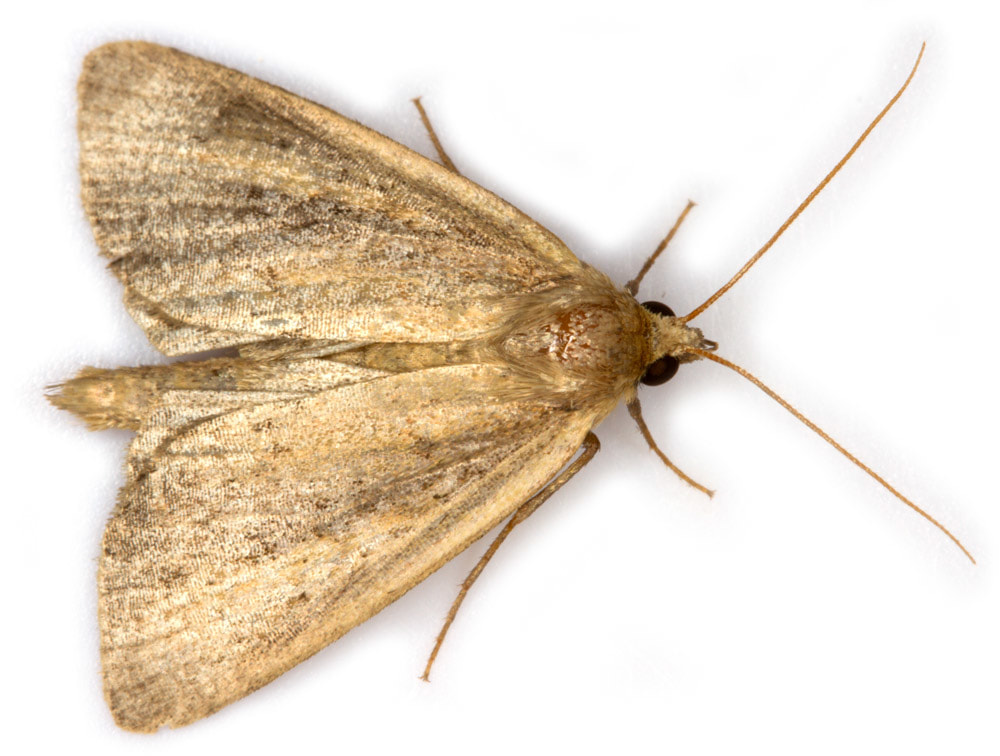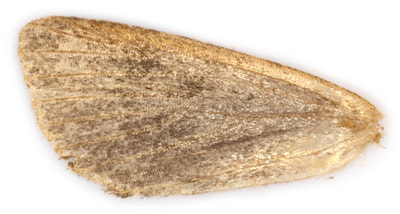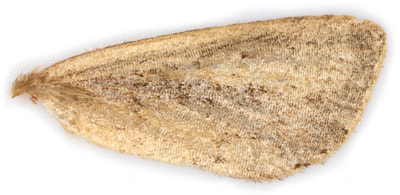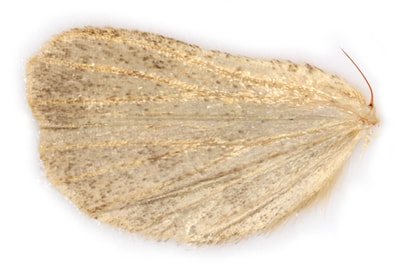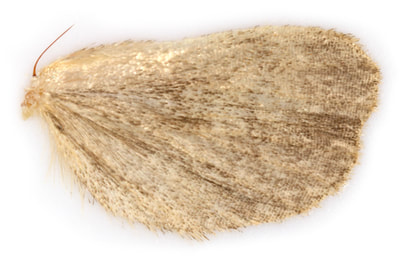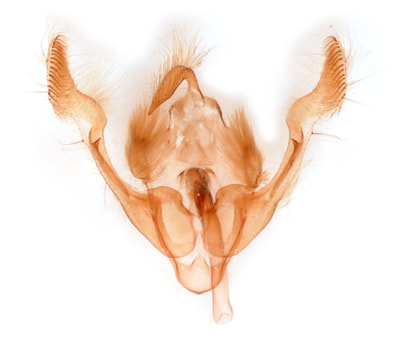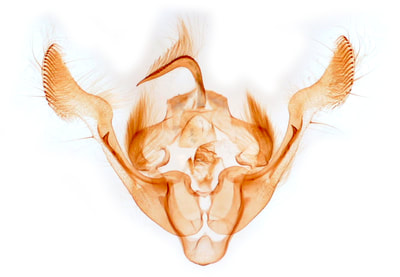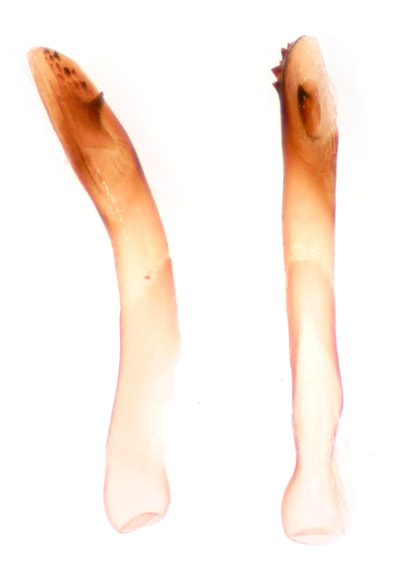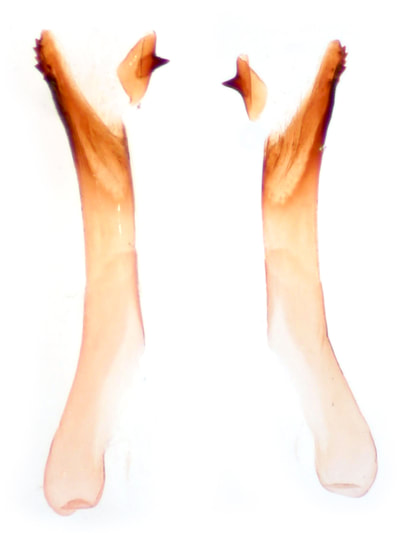73.140 Archanara neurica (White-mantled Wainscot)
ws: 26-29mm (MBGBI10), fw: 12-13mm (Waring & Townsend); Jul-Aug; common reed (Phragmites australis); RDB – in reedbeds on the Suffolk coast between Thorpness and Southwold.
ID: Very similar to A.dissoluta (Brown-veined Wainscot). A.neurica has a fairly distinctive white posterior edge to the patagia (when fresh) and lacks central spots on underside of forewing and hindwing. MBGBI10 comments that the patagia are unmarked in A.dissoluta, but I have found that a white posterior margin is sometimes present, especially in the melanic forms and this could be interpreted as a white collar leading to misidentification as A.neurica if the underside is not checked. A.dissoluta has a central fuscous spot on the underside of both forewing and hindwing.
Male genitalia: A.neurica but not A.dissoluta shown at Moth Dissection. A.dissoluta is probably treated in Pierce as "Arundineta; neurica", with A.neurica as "Neurica; edelsteni" - but this synonymy is not mentioned in MBGBI10. Comparing my own material diagnostic differences between the two species, with features of A.neurica given first, are: 1) the distal end of the harpe turns dorsally and ends in a pointed triangle vs turns ventrally and ends in a rounded club; 2) Cucullus with a long rounded lateral spined margin (cucullus slightly broader than it is long) vs cucullus with a short almost straight lateral margin (cucullus clearly longer than broad); 3) Dorsum of valva (costa) with a distinct rounded hump at junction of neck and cucullus vs much more evenly rounded at this junction; 4) Cornutus very close to apex of aedeagus vs cornutus near centre of aedeagal length; 5) Tunica scobinate near apex vs more strongly crested. (Pierce comments regarding A.neurica ("Neurica; edelsteni") "vesica with scobinated process where it joins the aedoeagus at the orifice" and regarding A.dissoluta (Arundineta; neurica) "aedoeagus strongly crested at the orifice"). The image of A.neurica at Moth Dissection is consistent with my observations for the valval features; the aedeagus shown at Moth Dissection, however, does not display the features mentioned here and is inconsistent with Pierce's description.
Female genitalia: A.dissoluta but not A.neurica is shown at Moth Dissection. Treated in Pierce as Meliana dissoluta with A.neurica treated as Meliana neurica, but again this synonymy is not mentioned in MBGBI10. Pierce describes the differences as: A.dissoluta - "..ostium arched; ductus bursae sides parallel longer than in neurica.."; and A.neurica - "..ostium angular, indent; ductus bursae short, bulbed...". The ostium of my two female specimens (see §8 below) is more "angular and indent" than "arched". The illustration in Pierce shows the ductus bursae extending to just beyond the apices of the anterior apophyses in A.dissoluta (as shown below for §7) but much shorter in A.neurica.
Male genitalia: A.neurica but not A.dissoluta shown at Moth Dissection. A.dissoluta is probably treated in Pierce as "Arundineta; neurica", with A.neurica as "Neurica; edelsteni" - but this synonymy is not mentioned in MBGBI10. Comparing my own material diagnostic differences between the two species, with features of A.neurica given first, are: 1) the distal end of the harpe turns dorsally and ends in a pointed triangle vs turns ventrally and ends in a rounded club; 2) Cucullus with a long rounded lateral spined margin (cucullus slightly broader than it is long) vs cucullus with a short almost straight lateral margin (cucullus clearly longer than broad); 3) Dorsum of valva (costa) with a distinct rounded hump at junction of neck and cucullus vs much more evenly rounded at this junction; 4) Cornutus very close to apex of aedeagus vs cornutus near centre of aedeagal length; 5) Tunica scobinate near apex vs more strongly crested. (Pierce comments regarding A.neurica ("Neurica; edelsteni") "vesica with scobinated process where it joins the aedoeagus at the orifice" and regarding A.dissoluta (Arundineta; neurica) "aedoeagus strongly crested at the orifice"). The image of A.neurica at Moth Dissection is consistent with my observations for the valval features; the aedeagus shown at Moth Dissection, however, does not display the features mentioned here and is inconsistent with Pierce's description.
Female genitalia: A.dissoluta but not A.neurica is shown at Moth Dissection. Treated in Pierce as Meliana dissoluta with A.neurica treated as Meliana neurica, but again this synonymy is not mentioned in MBGBI10. Pierce describes the differences as: A.dissoluta - "..ostium arched; ductus bursae sides parallel longer than in neurica.."; and A.neurica - "..ostium angular, indent; ductus bursae short, bulbed...". The ostium of my two female specimens (see §8 below) is more "angular and indent" than "arched". The illustration in Pierce shows the ductus bursae extending to just beyond the apices of the anterior apophyses in A.dissoluta (as shown below for §7) but much shorter in A.neurica.
Dissection
Male genitalia
§1 North Warren, Suffolk; 16/07/2017; male; fw 12.6mm; to light
All images © Chris Lewis
All images © Chris Lewis
Page published 22/07/2017 (§1)
